Tissues Multiple Choice Question and Answers
Question 1. Which type of epithelial tissue is found in the cells lining blood vessels?
- Squamous epithelium
- Cuboidal epithelium
- Columnar epithelium
- Ciliated epithelium
Answer: 1. Squamous epithelium
Question 2. The given illustration represents the human respiratory system. In the given illustration, the structure labeled I is lined with which type of epithelial tissue?
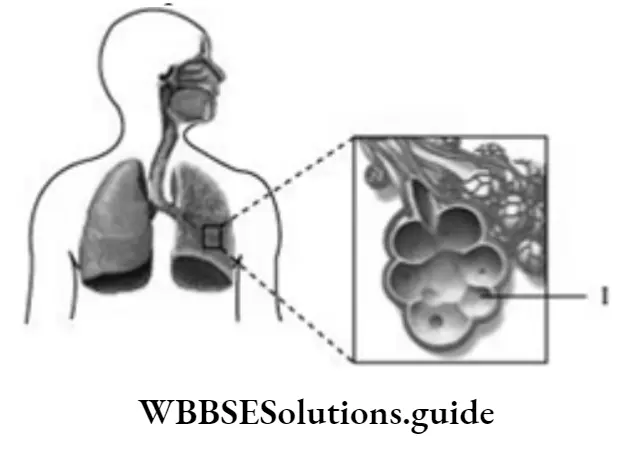
- Columnar epithelium
- Stratified squamous
- Cuboidal epithelium
- Simple squamous
Answer: 4. Simple squamous
“animal tissues mcqs “
Question 3. Skin is a protective body covering. Which epithelium is present in the skin?
- Stratified squamous epithelium
- Simple squamous epithelium
- Columnar epithelium
- Cuboidal epithelium
Answer: 1. Stratified squamous epithelium
NEET Biology Class 7 Tissues MCQs
Question 4. The goblet cells are specialized cells found in the intestine, which secrete mucus. Mucus acts as a lubricant. Which of the following epithelial cells is modified as goblet cells?
- Cuboidal epithelium
- Columnar epithelium
- Simple squamous epithelium
- Stratified squamous epithelium
Answer: 2. Columnar epithelium
Question 5. Ciliated columnar epithelium, which is made of cilia, is found in the lining of the
- Respiratory tract
- Kidney tubules
- Oesophagus
- Mouth
Answer: 1. Respiratory tract
Question 6. 1 epithelium is present in the internal lining of kidney tubules. 2 is present in the lining of the small intestine. The information in which alternative completes the given statements?
- 1-columnar 2-it is also
- 1-cuboidal 2-it is also
- 1-cuboidal 2- 2-columnar epithelium is
- The 1-columnar 2-cuboidal epithelium is
Answer: 3. 1-cuboidal 2- columnar epithelium is
Tissues NEET MCQs with Answers
Question 7. The linings of 1 and 2 are made of simple squamous epithelial cells. The information in which alternative completes the given statement?
- 1-oesophagus 2-blood vessels
- 1-kidney 2-blood vessels
- 1-kidney tubules 2-intestines
- 1-esophagus 2-intestines
Answer: 1. 1-esophagus 2-blood vessels
Question 8. The matrix of 1 is composed of compounds of phosphorus and calcium. The matrix of composed of 2 proteins and sugars. The information in which alternative completes the given statements?
- 1-cartilage 2-bone is
- 1-bone 2-bone is also
- 1-cartilage 2-cartilage is also
- 1-bone 2-cartilage is
Answer: 4. 1-bone 2-cartilage is
Question 9. Blood is a type of connective tissue. Which of the following statements about the functions of blood is correct?
- It helps in transporting gases and nutrients
- It helps in connecting bones to muscles
- It helps in the digestion of food
- It helps in the storage of fats
Answer: 1. It helps in transporting gases and nutrients
NEET Biology Tissues Important MCQs
Question 10. In the human respiratory system, the air enters the nostrils and is transported to the lungs through the trachea. A particular connective tissue lines the trachea and prevents it from collapsing. Which connective tissue supports the trachea?
- Adipose
- Ligament
- Tendon
- Cartilage
Answer: 4. Cartilage
“animal tissue mcqs “
Question 11. The given illustrates a type of connective tissue. In the given, the structure labeled ‘X’ is composed of which types of cells?
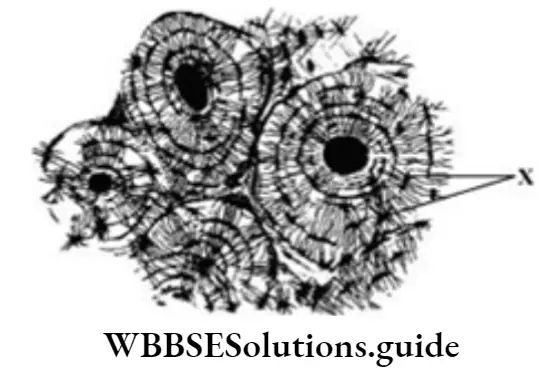
- Adipocytes
- Osteocytes
- Monocytes
- Lymphocytes
Answer: 2. Osteocytes
Best Multiple Choice Questions for Class 7 Biology Tissues
Question 12. Polar bears live at the North Pole. They have a number of adaptations to enable them to live in harsh conditions. For example, they have a thick layer of blubber (fat) up to 11 cm, which helps them keep warm while swimming in cold water. Which type of tissues helps the polar bear in the given situation?
- Areolar tissue
- Adipose tissue
- Cartilage tissue
- Skeletal tissue
Answer: 2. Adipose tissue
Question 13. 1 Muscle fiber helps in the contraction and relaxation of blood vessels. It is spindle in shape and in 2 actions. The information in which alternative completes the given statements?
- 1-smooth 2-voluntary
- 1-skeletal 2-voluntary
- 1-smooth 2-involuntary
- 1-skeletal 2-involuntary
Answer: 3. 1-smooth 2-involuntary
Question 14. Smooth muscle cells are found in 1 and 2. The information in which alternative completes the given statement?
- 1-bronchi 2-hands
- 1-bronchi 2-iris
- 1-heart 2-iris
- 1-heart 2-hands
Answer: 2. 1-bronchi 2-iris
Question 15. The given illustration represents a type of muscle. The type of muscle shown in the given illustration is likely to be found in the
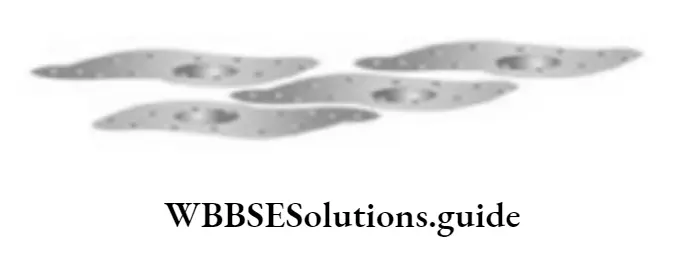
- Muscles of arms
- Muscles of legs
- Stomach
- Heart
Answer: 3. Stomach
“animal tissue mcqs “
Question 16. The esophagus helps in the passage of food from the mouth to the stomach. The muscle cells present in the esophagus are 1 and 2. The information in which alternative completes the given statement?
- 1-multinucleate 2-spindle shaped
- 1-uninucleate 2-cylindrical
- 1-multinucleate 2-cylindrical
- 1-uninucleate 2-spindle shaped
Answer: 4. 1-uninucleate 2-spindle shaped
Question 17. The given illustrates the types of muscle tissues. The information in which alternative correctly completes the given flowchart?
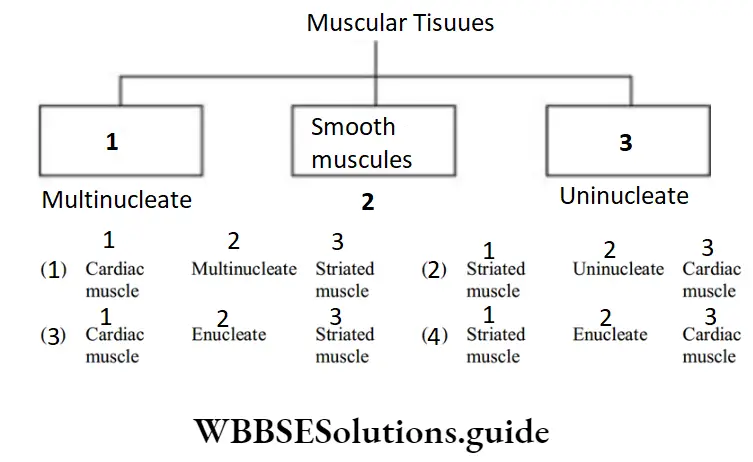
Answer: 2.

Tissues Class 7 NEET Objective Questions
Question 18. The given illustration represents a neuron. In the given illustration, the structure labeled 1 is the
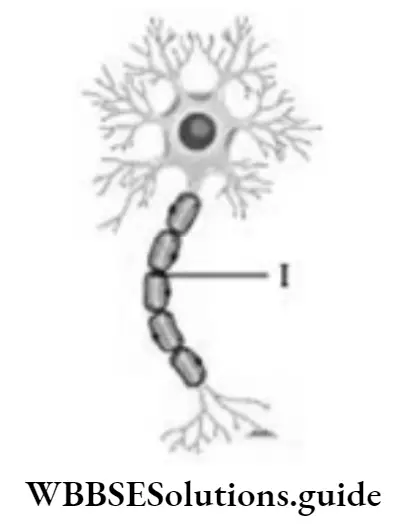
- Nerve ending
- Cell body
- Dendrite
- Axon
Answer: 4. Axon
Question 19. Which connective tissue helps in storing fats?
- Tendon
- Ligament
- Adipose tissue
- Areolar tissue
Answer: 3. Adipose tissue
Question 20. Bones and muscles are connected to each other with the help of connective tissue. Which connective tissue joins muscles to bones?
- Tendon
- Ligament
- Areolar tissue
- Adipose tissue
Answer: 1. Tendon
“animal tissue mcqs “
Question 21. The given illustrates the structure of nerve cells. All the activities of the cell are controlled by the part labeled as
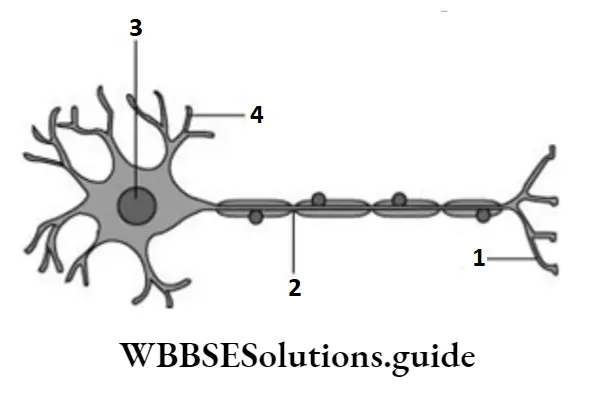
- 1
- 2
- 3
- 4
Answer: 3. 3
NEET Biology Class 7 Chapter 3 MCQs with Solutions
Question 22. The given illustrates some animal tissues. Which of the following statements best describes the relationship between the cells in the given?
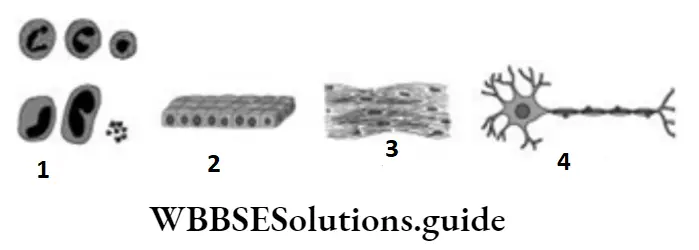
- 4 transmits messages to 3.
- 3 transports oxygen to 2.
- 1 is synthesised by 4.
- 3 is composed of 1.
Answer: 1. 4 transmits messages to 3.
Question 23. 1 meristem is responsible for the increase in the length of the stem and roots. 2 responsible for the increase in the girth of the stem and roots. The information in which alternative completes the given statements?
- 1-laterl 2-apical meristem is
- 1-apical 2-lateral meristem is
- 1-apical 2-apical meristem is also
- 1- lateral 2-lateral meristem is also
Answer: 2. 1-apical 2-lateral meristem is
Question 24. This illustrates the location of meristematic tissues in plants. The label ‘X’ in the given illustration is 1 meristem which helps in increasing the 2 of stem and root.
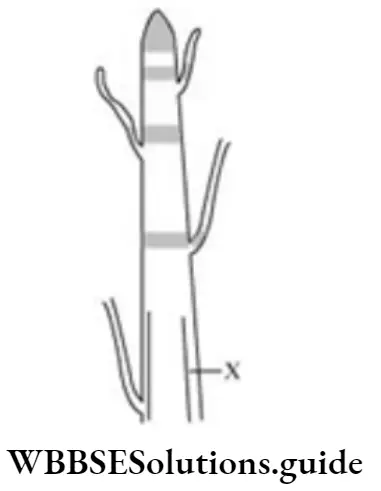
- 1-apical 2-thickness
- 1-apical 2-length
- 1-lateral 2-thickness
- 1-lateral 2-length
Answer: 3. 1-lateral 2-thickness
Question 25. Which of the following organelles is absent in the cells of the meristematic tissue?
- Nucleus
- Vacuoles
- Ribosomes
- Mitochondria
Answer: 2. Vacuoles
“animal tissue mcqs “
Question 26. In plants, meristematic tissue is of three types. The 1 helps in increasing the length of the plant while the intercalary meristem helps in the 2 growth of plants and the 3 meristem helps in increasing the thickness of plants. The information in which alternative completes the given statement?
- 1-lateral meristem 2-longitudinal 3-apical
- 1-apical meristem 2-equatorial 3- lateral
- 1-lateral meristem 2-equatorial 3-apical
- 1-apical meristem 2-longitudinal 3-lateral
Answer: 4. 1-apical meristem 2-longitudinal 3-lateral
Question 27. The given illustrates the section of a stem. In the given, which labeled structure helps in increasing the girth of a banyan tree?
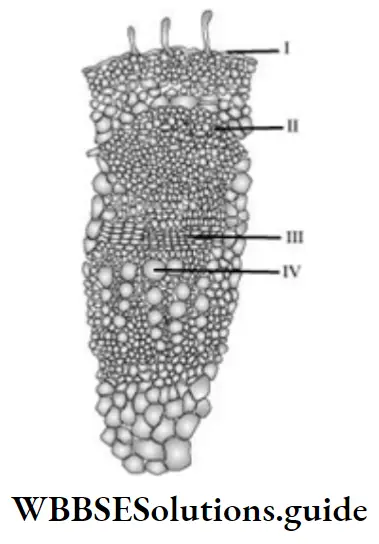
- 1
- 2
- 3
- 4
Answer: 3. 3
Question 28. Which type of permanent tissue helps in storing food in plants?
- Parenchyma
- Collenchyma
- Xylem
- Phloem
Answer: 1. Parenchyma
Question 29. Simple permanent tissue is made of only one type of cells. Which type of permanent plant tissue provides buoyancy to aquatic plants?
- Chlorenchyma
- Sclerenchyma
- Aerenchyma
- Collenchyma
Answer: 3. Aerenchyma
Question 30. Permanent plant tissues are of two types: simple and complex. Which type of simple permanent tissue provides flexibility to plants?
- Parenchyma
- Aerenchyma
- Collenchyma
- Sclerenchyma
Answer: 3. Collenchyma
Question 31. Stomata are present on the epidermis of the leaf. What is the primary function of stomata?
- Storage
- Photosynthesis
- Providing flexibility
- Carrying out gaseous exchange
Answer: 4. Carrying out gaseous exchange
Question 32. The epidermis of some desert plants is covered with a thick, waxy coating of a chemical called 1 . 2 The chemical is present in the walls of cork cells. It makes them impervious to water. The information in which alternative completes the given statements?
- 1-cutin 2-suberin is
- 1-suberin 2-cutin is
- 1-cutin 2-cutin is also
- 1-suberin 2- suberin is also
Answer: 1. 1-cutin 2-suberin is
Question 33. Some fruits such as plums and apricots have a hard coving over their seeds. Almond fruit has a hard covering over its seeds because of the presence of
- Parenchyma
- Aerenchyma
- Collenchyma
- Sclerenchyma
Answer: 4. Sclerenchyma
Question 34. The alternatives in the given table can be correctly matched as
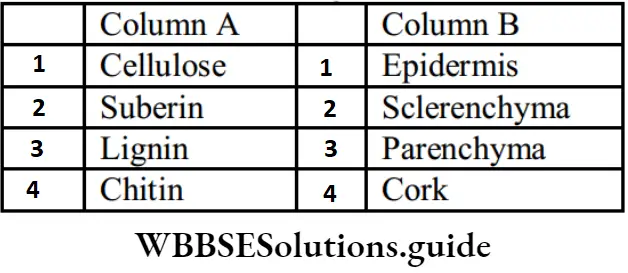
- 1 → d, 2 → c, 3 → a, 4 → b
- 1 → c, 2 → d, 3 → b, 4 → a
- 1 → b, 2 → a, 3 → c, 4 → d
- 1 → c, 2 → b, 3 → a, 4 → d
Answer: 2. 1 → c, 2 → d, 3 → b, 4 → a
Question 35. The given list presents some of the simple permanent tissues found in plants.
- Parenchyma
- Collenchyma
- Sclerenchyma
- Epidermis
- Cork
Which of the following pairs of tissues are made up of dead cells?
- 1 and 3
- 2 and 4
- 3 and 5
- 1 and 5
Answer: 3. 3 and 5
“animal tissue mcqs “
Question 36. The given illustrates the types of plant tissues.
The information in which alternative correctly completes the given?
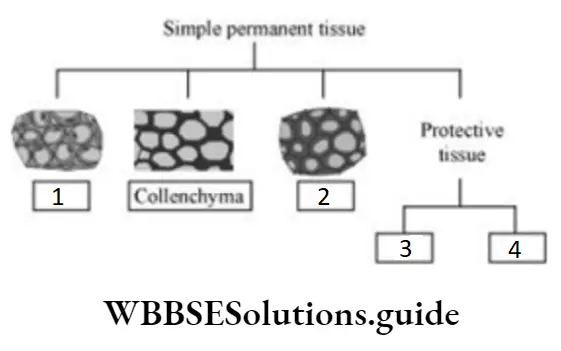
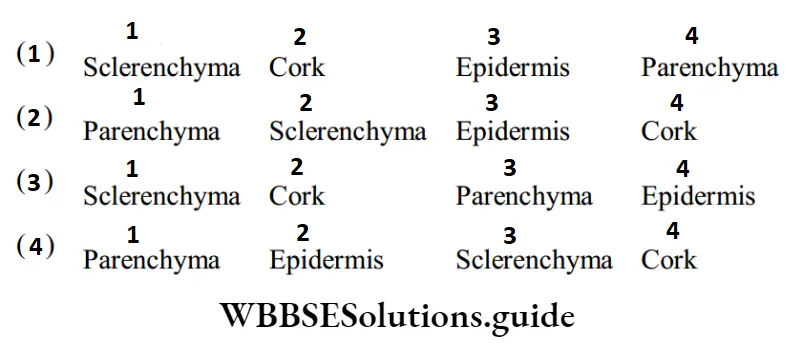
Answer: 2. 
Question 37. 2 conducts water and minerals from the roots to different parts of the plant. This movement of water and minerals is 2. The information in which alternative completes the given statements?
- 1-xylem 2-unidirectional
- 1-xylem 2-bidirectional
- 1-problem 2-undirectional
- 1-pholem 2-bidirectional
Answer: 1. 1-xylem 2-unidirectional
Tissues Conceptive Worksheet
Question 1. The primary function of the cells of the nervous tissue is to
- Protect the internal organs
- Transmit stimulus
- Transport oxygen
- Aid in movement
Answer: 2. Transmit stimulus
Question 2. The cells of the tissue that transmit stimulus are known as. The information in which alternative completes the given statement?
- 1-nervous 2-muscle
- 1-muscular 2-muscles
- 1-nervous 2-neurons
- 1-muscular 2-neurons
Answer: 4. 1-muscular 2-neurons
Question 3. The given illustration represents a neuron. In the given illustration, the cell body of the neuron is labeled as
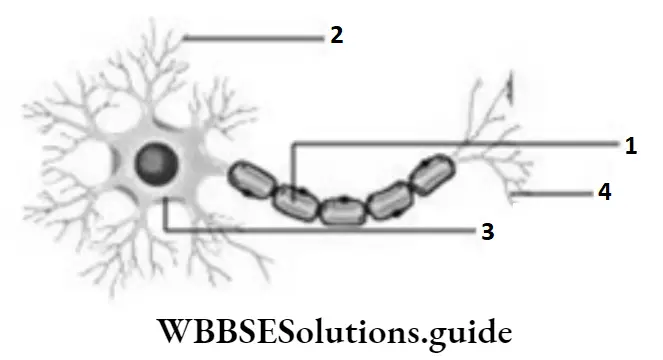
- 1
- 2
- 3
- 4
Answer: 3. 3
Question 4. The given illustration represents a neuron. In the given illustration, the structure labeled X is the
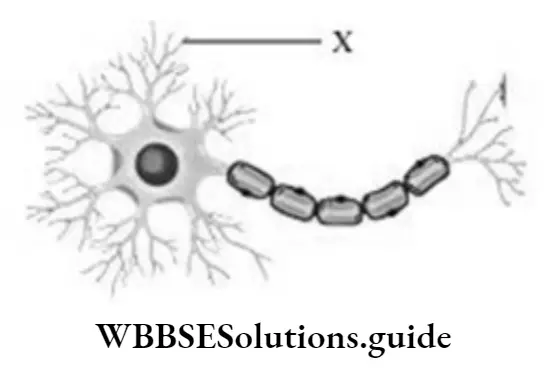
- Axon
- Dendrite
- Cell body
- Nerve ending
Answer: 2. Dendrite
“animal tissue mcqs “
Question 5. The given illustration represents a type of muscle fiber. The illustrated muscle fiber is present in the
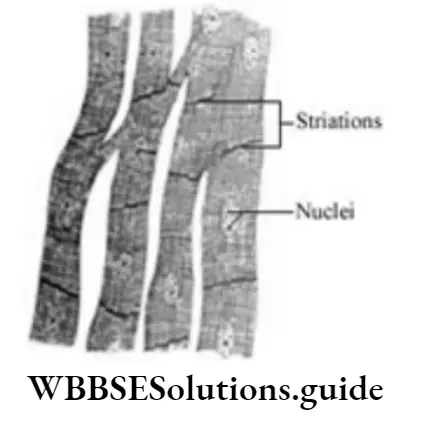
- Heart
- Ureters
- Iris of the eyes
- Bronchi of the lungs
Answer: 1. Heart
Question 6. Involuntary muscles control the movement of food in the alimentary canal. The cells of involuntary muscles are
- Cylindrical and uninucleate
- Cylindrical and multinucleate
- Spindle-shaped and uninucleate
- Spindle-shaped and multinucleate
Answer: 3. Spindle-shaped and uninucleate
Question 7. The muscles of the heart are known as i muscles, whereas the muscles found in the ureters are known as ii muscles. The information in which alternative completes the given statement?
- 1-cardiac 2-striated
- 1-cardiac 2-smooth
- 1-skeletal 2-smooth
- 1-skeletal 2-striated
Answer: 2. 1-cardiac 2-smooth
Question 8. The cells of voluntary muscles are long, cylindrical, 1, and 2. The information in which alternative completes the given statement?
- 1-branched 2-uninucleate
- 1-branched 2-multinucleate
- 1-unbranched 2-uninucleate
- 1-unbranched 2 -multinucleate
Answer: 4. 1-unbranched 2 -multinucleate
Question 9. Which of the following statements about bone is incorrect?
- It stores fats
- It is non-flexible and strong
- It contains calcium and phosphorus compounds
- It anchors muscles and protects the delicate organs of the body
Answer: 1. It stores fats
Question 10. Which of the following statements about blood is incorrect?
- It transports gases to various parts of the body
- It forms the framework of the body
- It has a fluid matrix
- It contains proteins
Answer: 2. It forms the framework of the body
Question 11. The tissue found between the skin and muscles is called 1 tissue. Fats are stored in the tissue. The information in which alternative completes the given statements?
- 1-areolar 2-cartilage
- 1-areolar 2-adipose
- 1-ligament 2-cartilage
- 1-ligament 2-adipose
Answer: 2. 1-areolar 2-adipose
Question 12. Cartilage has a solid matrix that is composed of 1 and 2. The information in which alternative completes the given statement?
- 1-calcium 2-phosphorus
- 1-proteins 2-calcium
- 1-sugars 2-phosphorus
- 1-proteins 2-sugars
Answer: 4. 1-proteins 2-sugars
Question 13. Which connective tissue transports gases, nutrients, and wastes to different body parts?
- Bone
- Blood
- Ligament
- Cartilage
Answer: 2. Blood
“animal tissue mcqs “
Question 14. Ligaments that connect two 1 are a type of 2 tissue. The information in which alternative completes the given statement?
- 1-bones 2-muscular
- 1-muscles 2-muscular
- 1-bones 2-connective
- 1-muscles 2-connective
Answer: 2. 1-muscles 2-muscular
Question 15. What is the primary function of cuboidal epithelium?
- To prevent wear and tear
- To provide useful secretions
- To prevent microbial infection
- To provide mechanical support
Answer: 3. To prevent microbial infection
Question 16. The given represents a cell present in the inner lining of the gut. Which epithelial tissue is represented in the given?
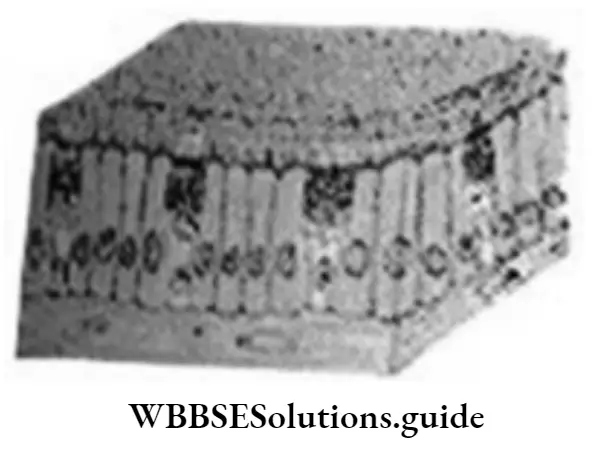
- Stratified squamous epithelium
- Simple squamous epithelium
- Columnar epithelium
- Cuboidal epithelium
Answer: 3. Columnar epithelium
Question 17. Which illustration represents stratified squamous epithelium?
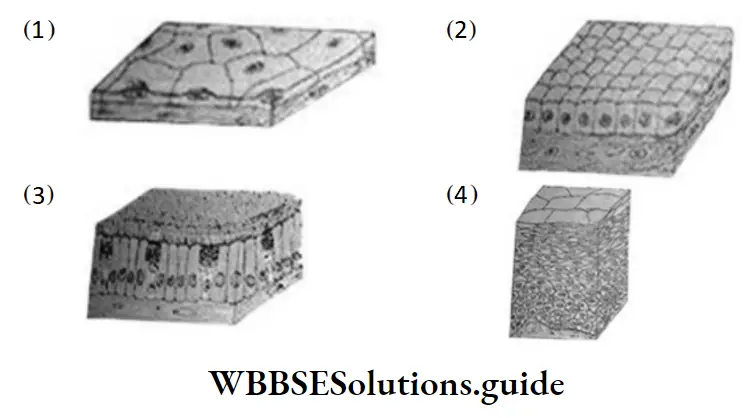
Answer: 4.
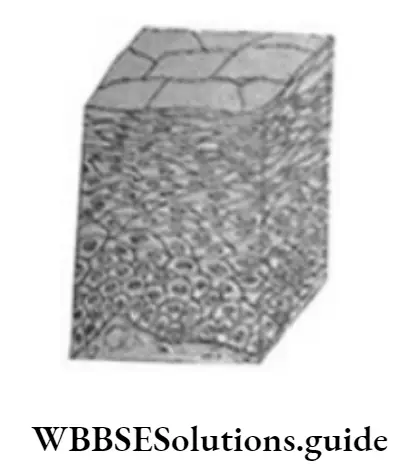
Question 18. Which epithelial tissue forms the lining of the mouth?
- Stratified squamous
- Simple squamous
- Columnar
- Cuboidal
Answer: 4. Cuboidal
Question 19. The linings of 1 and the ducts of salivary glands are formed by 2 epithelium, which provides mechanical support to these structures. The information in which alternative completes the given statement?
- 1-kidney tubules 2-tubules
- 1-lung alveoli 2-columnar
- 1-kidney tubules 2-cuboidal
- 1-lung alveoli 2-cuboidal
Answer: 3. 1-kidney tubules 2-cuboidal
Multiple Choice Questions on Tissues for NEET Exam
Question 20. Which type of epithelium is present in the inner lining of the intestine?
- Stratified squamous
- Simple squamous
- Columnar
- Cuboidal
Answer: 3. Columnar
Question 21. Which type of epithelium is illustrated in the given?
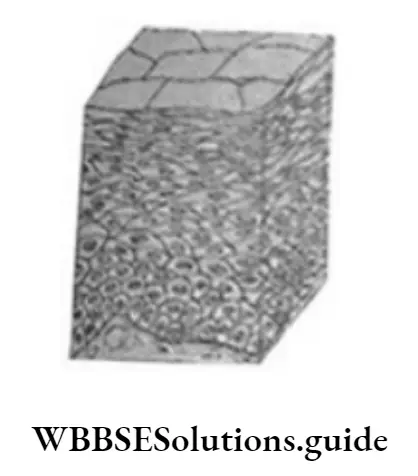
- Simple squamous
- Stratified squamous
- Cuboidal epithelium
- Columnar epithelium
Answer: 2. Stratified squamous
Question 22. Simple squamous epithelial cells are extremely 1 and 2. The information in which alternative completes the given statement?
- 1-thick 2-columnar
- 1-thick 2-flat
- 1-thin 2-columnar
- 1-thin 2-flat
Answer: 4. 1-thin 2-flat
Question 23. The xylem is a complex permanent tissue, which is made of four different components. The tracheids and vessels are made up of dead cells and help in the vertical transportation of water and minerals. Which type of cells make up the tracheids and vessels?
- Aerenchyma
- Collenchyma
- Chlorenchyma
- Sclerenchyma
Answer: 4. Sclerenchyma
Question 24. In an experiment to study parasitism in rice plants, it was found that a species of fungi was able to penetrate the stem of rice plants. The fungi produced chemicals that degraded
- Cellulose
- Cuticle
- Suberin
- Lignin
Answer: 2. Cuticle
Question 25. Piyush cut a branch of a dicot plant and put it in blue ink. After 2 hours, he observed that the leaves as well as the stem had turned blue. The parts of the stem and leaf respectively which have turned blue first are
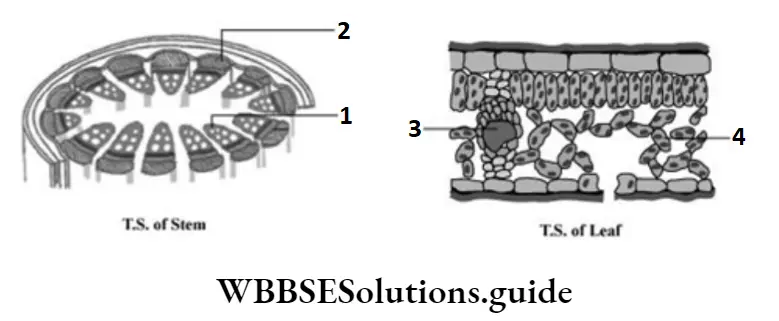
- 1 and 3
- 2 and 3
- 1 and 4
- 2 and 1
Answer: 1. 1 and 3
Question 26. Which tissue constitutes the husk of a coconut?
- Aerenchyma
- Collenchyma
- Sclerenchyma
- Chlorenchyma
Answer: 3. Sclerenchyma
Question 27. Collenchyma consists of i cells that have ii intercellular spaces between them. The information in which alternative completes the given statement?
- 1-dead 2-no
- 1-dead 2-small
- 1-living 2-no
- 1-living 2-small
Answer: 4. 1-living 2-small
Question 28. ____1_____ is a type of complex permanent tissue that helps in the bi-directional transportation of ____2_____ in plants. The information in which alternative completes the given statement?
- 1-pholem 2-food
- 1-pholem 2-water
- 1-xylem 2-food
- 1-xylem 2-water
Answer: 1. 1-pholem 2-food
Question 29. In plants, water and minerals are primarily transported through
- Tracheids and vessels
- Tracheids and sieve tubes
- Vessels and companion cells
- Sieve tubes and companion cells
Answer: 1. Tracheids and vessels
Question 30. Phloem is a type of complex permanent tissue that helps in the translocation of food. Which component of the phloem consists of dead cells?
- Sieve tube
- Phloem fiber
- Companion cell
- Phloem parenchyma
Answer: 2. Phloem fibre
Question 31. Sieve tubes and companion cells are components of
- Xylem
- Phloem
- Collenchyma
- Parenchyma
Answer: 2. Phloem
Question 32. In the xylem, 1 helps in the sideways conduction of water and 2 plays a supportive role. The information in which alternative completes the given statement?
- 1-vessel 2-tracheids
- 1-tracheids 2-parenchyma
- 1-parenchyma 2-fibers
- 1-fibers 2-vessels
Answer: 3. 1-tracheids 2-parenchyma
Question 33. The structural components that conduct water and nutrients vertically in the xylem are 1 and 2. The information in which alternative completes the given statement?
- 1-companion cells 2-tracheids
- 1-companion cells 2-sieve tubes
- 1-vessels 2-sieve tubes
- 1-vessels 2-tracheids
Answer: 4. 1-vessels 2-tracheids
Question 34. The given represents the different types of complex permanent tissue in plants.
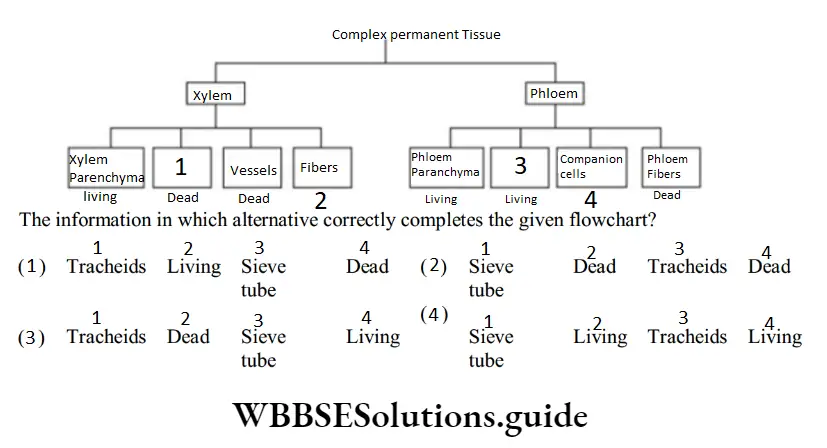
Answer: 3.

Question 35. The flow of food material in the phloem is i and the cells of ii aid in this transport. The information in which alternative completes the given statement?

Answer: 1.

Tissues Summative Worksheet MCQs
Question 1. Which of the following is a protective tissue?
- Muscular tissue
- Connective tissue
- Epithelial tissue
- Nervous tissue
Answer: 3. Epithelial tissue
NEET Study Material for Tissues with MCQs
Question 2. The tissue that forms the internal lining of organs is
- Nervous tissue
- Epithelial tissue
- Connective tissue
- A muscle
Answer: 2. Epithelial tissue
Question 3. Nervous tissue consists of
- Nerve cells
- Tendons
- Cyton
- Lymph
Answer: 1. Nerve cells
Question 4. Short branching structures arising from the cell body of a neuron are called
- Axons
- Cyton
- Dendrites
- Lymph
Answer: 3. Dendrites
Question 5. The muscles that take part in breathing movements are
- Involuntary muscles
- Cardiac muscles
- Voluntary muscles
- All the above
Answer: 1. Involuntary muscles
Question 6. Muscles found in the heart are
- Voluntary muscles
- Cardiac muscles
- Involuntary muscles
- All the above
Answer: 2. Cardiac muscles
Question 7. Tissues found in growing regions are
- Meristematic tissues
- Complex tissues
- Simple tissues
- Permanent tissues
Answer: 1. Meristematic tissues
Question 8. Meristematic tissues have
- Small, thin-walled cells rich in cytoplasm
- Small, thick-walled cells
- Dead cells
- Cells that can divide for a short period
Answer: 1. Small, thin-walled cells rich in cytoplasm
Question 9. Sclerenchyma is a
- Thick-walled tissue consisting of dead cells
- Thick-walled tissue consisting of living cells
- Thin-walled, living cells
- None of the above
Answer: 1. Thick-walled tissue consisting of dead cells
Question 10. Vascular tissues in a plant are
- Xylem and phloem
- Xylem, phloem, and epidermis
- Only xylem
- Only phloem
Answer: 1. Xylem and phloem
Tissues Fill In The Blanks
Question 1. About two-thirds of the body weight is made up of ____________ tissue.
Answer: Muscular tissues
Question 2. Bone is a type of ____________ tissue.
Answer: Skeletal
Question 3. Nerve cells are also called ____________
Answer: Neurons
Question 4. Nerve cells are found in ____________ and ____________.
Answer: Brain, spinal cord
Question 5. ____________ muscles are found in the walls of the stomach and
intestine.
Answer: Smooth (or unstriated)
Question 6. Cells are living, elongated, and thickened at the corners in
____________ tissue.
Answer: Muscular tissue
Question 7. Xylem and phloem constitute ____________ tissue in a plant body.
Answer: Vascular tissue
Question 8. Water moves upward inside the plant body through ____________ tissue.
Answer: Xylem
Question 9. The movement of food material in the plant body takes place through
____________ tissue.
Answer: Phloem
Question 10. Permanent tissues arise from ____________ tissues.
Answer: Meristematic
Question 11. Cells of ____________ tissue bring about an increase in plant length.
Answer: Meristematic
Find The Odd One Out, Giving Reasons
Question 1. Cyton, dendrite, plasma, axon
Answer: Plasma
Question 2. Bone, cartilage, tendon, blood
Answer: Blood
Question 3. Bone, epithelium, tendon, cartilage
Answer: Epithelium
Question 4. Xylem, collenchyma, parenchyma, sclerenchyma
Answer: Xylem
Question 5. Vessels, companion cells, sieve tubes, collenchyma.
Answer: Collenchyma
Tissues Following Write True Or False
Question 1. Meristematic cells are small and thin-walled.
Answer: True
Question 2. Cells of the permanent tissues lack the property of division.
Answer: True
Question 3. Permanent tissue is an immature tissue.
Answer: False
Question 4. Stomata are present in the ground tissue of the leaf.
Answer: False
Question 5. Xylem tissue is made of sieve tubes.
Answer: False
Question 6. Epithelial tissue is a protective tissue.
Answer: True
Question 7. Muscular tissues show the properties of contraction and expansion.
Answer: True
Tissues Class 7 NCERT MCQs with Answer Key
Question 8. Cyton and axons are the parts of a nerve cell.
Answer: True
Question 9. The fluid part of the blood is called plasma.
Answer: True
Question 10. Sclerenchyma consists of thick-walled dead cells.
Answer: True
Question 11. The phloem is a complex tissue.
Answer: True
